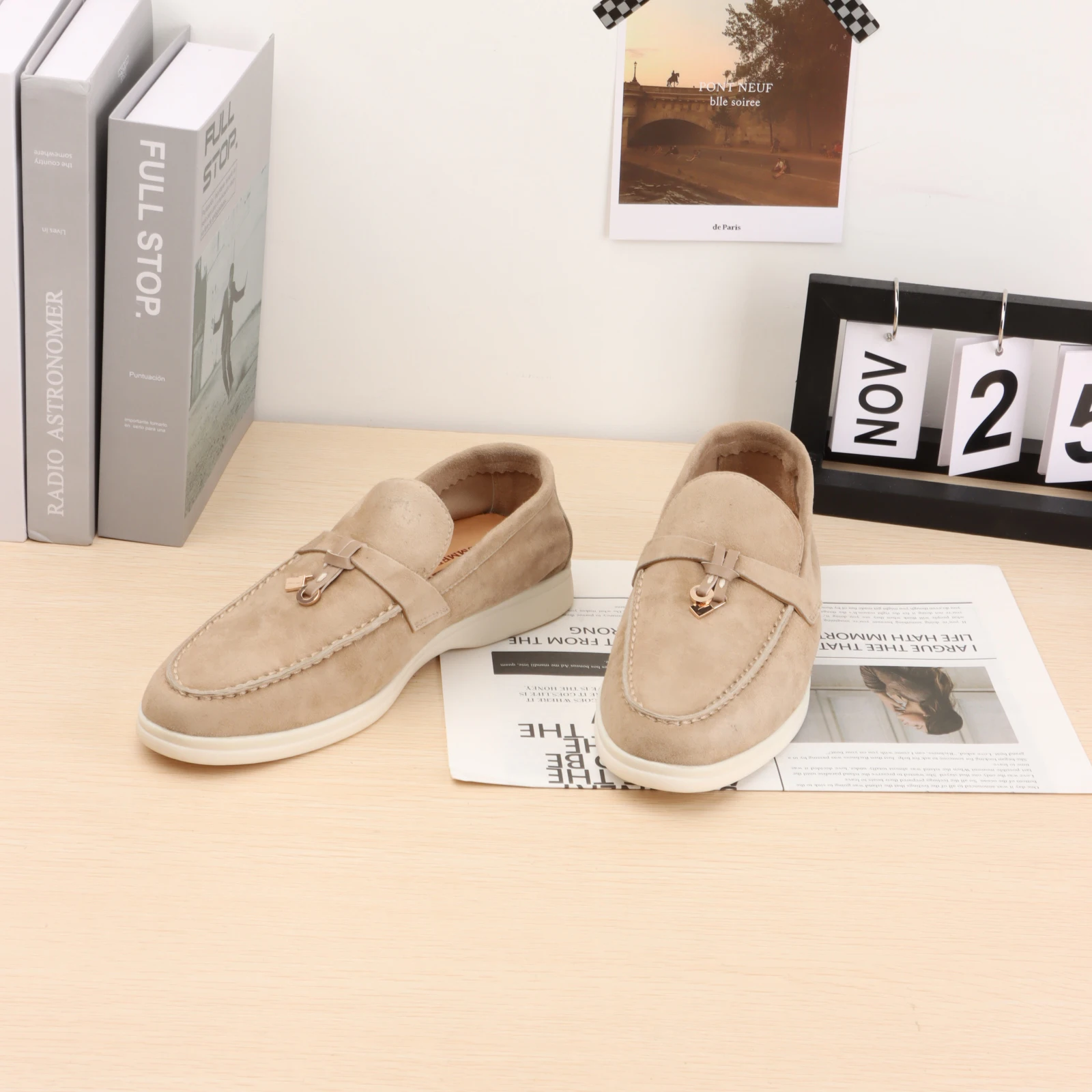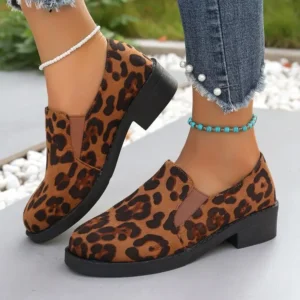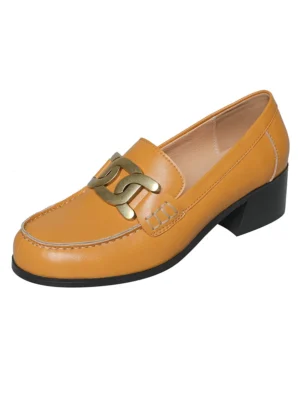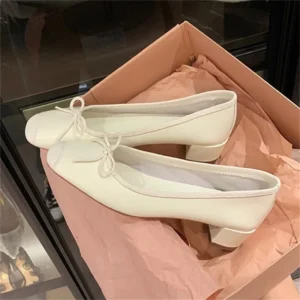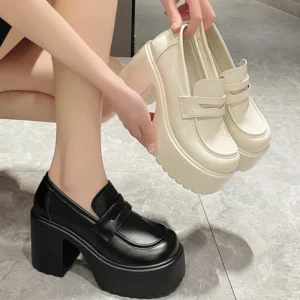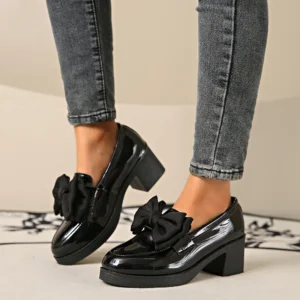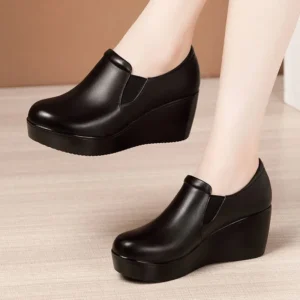1. Why Proper Care is Essential for Your Leather Loafers with Heels
Leather loafers with heels aren’t just footwear—they’re investments that deserve proper attention. Quality leather shoes can be your faithful companions for many years, but only with the right care routine. Without proper maintenance, even the finest leather loafers will deteriorate quickly, losing their shape, shine, and comfort.
Heeled loafers face unique challenges that flat styles don’t encounter:
– Concentrated pressure on heel areas causes faster wear
– Leather creasing occurs differently due to the foot position
– Structural integrity requires special attention to prevent wobbling
– Different materials between the upper and heel demand varied care approaches
With consistent proper care, your leather loafers with heels can easily last 3-5 years longer than neglected pairs, maintaining their sophisticated appearance while remaining comfortable. This attention to detail also ensures your professional office loafer outfits continue to make the right impression in any setting.
2. Understanding Your Leather Loafers: Materials and Construction
2.1 Types of Leather and Their Specific Care Needs
The first step in proper shoe care is identifying what type of leather your loafers are made from:
Full-grain leather: This premium material shows natural markings and develops a rich patina over time. It requires regular conditioning to prevent drying and cracking but rewards you with incredible durability and character.
Patent leather: Recognizable by its high-gloss finish, patent leather needs specialized cleaners that won’t damage the shiny coating. Avoid oil-based products that can dull the gleaming surface.
Suede/nubuck variations: These velvety textures require gentle brushing rather than wet cleaning. For detailed information about preserving these delicate materials, our care guide for suede loafers provides specialized techniques.
Identifying your leather type is crucial—the wrong products can permanently damage your beautiful loafers.
2.2 Key Components Requiring Special Attention
Your leather loafers consist of several distinct parts, each needing specific care:
Upper material: This visible leather portion requires regular cleaning and conditioning to prevent cracks and maintain flexibility.
Lining: The interior leather or fabric that contacts your foot needs periodic deodorizing and gentle cleaning to prevent odor buildup and deterioration.
Soles: Edge care prevents fraying and separation from the upper leather, while the bottom surface benefits from occasional edge dressing.
Heels: Whether made from stacked leather, wrapped leather, or synthetic materials, heels are particularly vulnerable to scuffs, uneven wear, and detachment. Their condition directly affects your stability and comfort.
Our collection of women’s leather heeled loafers showcases the quality construction that benefits most from these careful attention practices.
3. Essential Care Products and Tools for Leather Loafers with Heels
3.1 Cleaning Supplies
Gathering the right tools makes proper leather care much easier:
Soft bristle brushes: Horsehair brushes work best for smooth leather, while specialized rubber or suede brushes safely clean textured leathers.
Leather-specific cleaners: Choose pH-balanced formulas designed for your specific leather type—what works for smooth leather can damage suede or patent finishes.
Microfiber cloths: These lint-free options are gentle enough for delicate leather while effectively removing dirt and applying products evenly.
3.2 Conditioning and Nourishing Products
Keeping leather supple prevents cracks and extends the life of your loafers:
Leather conditioners: These replenish essential oils that evaporate over time, preventing leather from becoming brittle.
Polishes: Available in colored and neutral options, polishes add protection while enhancing appearance. Match colored polish precisely to your loafer shade.
Patent leather products: Special formulations designed to maintain the high-gloss finish without causing cloudiness or peeling.
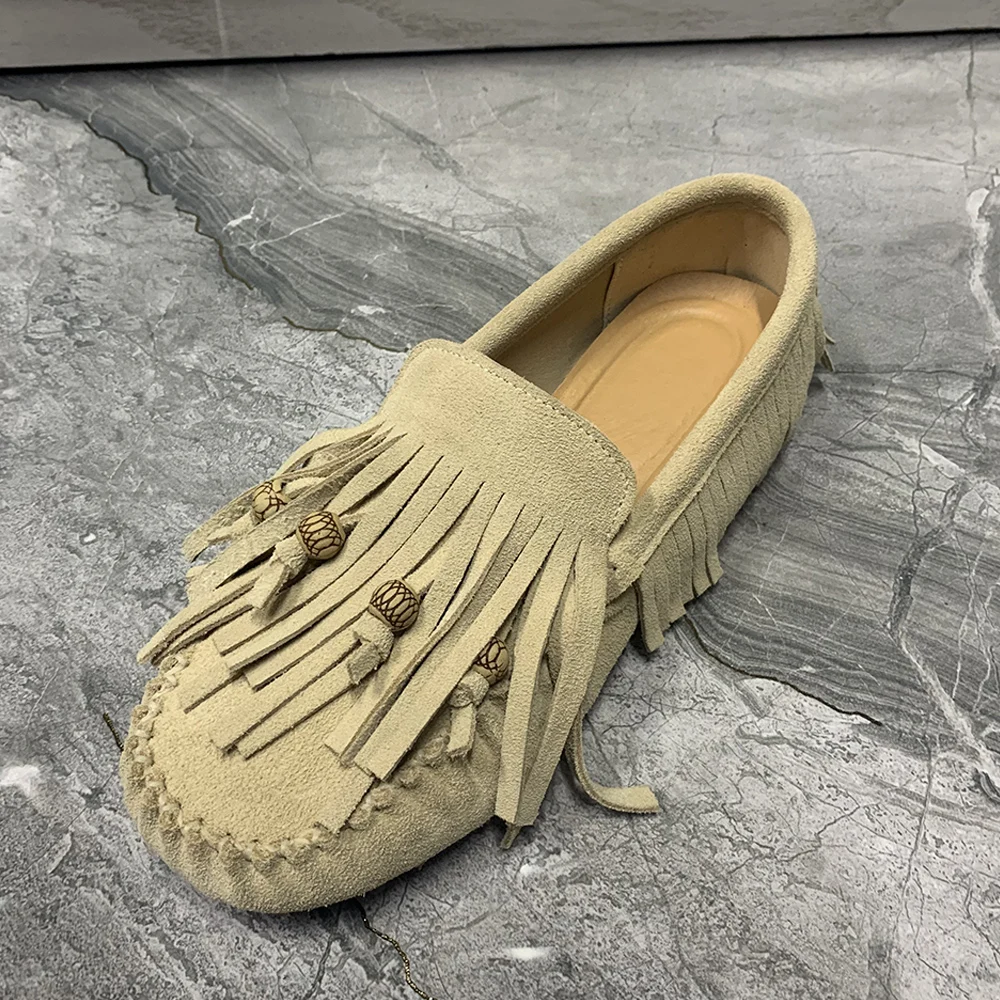
3.3 Protection and Preservation Tools
Preventative care saves both your shoes and your budget:
Water and stain repellents: Create an invisible barrier against moisture and stains without changing the leather’s appearance.
Cedar shoe trees: These absorb moisture, eliminate odors, and maintain your loafer’s shape between wears—truly essential for quality footwear.
Heel protectors: Small caps that prevent heel tips from wearing down, especially helpful on rough surfaces or for frequent wearers.
For detailed information on keeping your footwear pristine, our ultimate guide to pristine leather loafers offers comprehensive leather cleaning techniques.
4. Step-by-Step Care Routine for Leather Loafers with Heels
4.1 Regular Maintenance (After Each Wear)
Make these quick steps part of your routine after wearing your loafers:
Gently remove surface dust and debris using a soft brush, working in one direction to avoid scratching the leather.
Wipe the entire surface with a dry, clean cloth to remove any remaining particles and skin oils that could damage the leather over time.
Insert cedar shoe trees immediately after removing your loafers to maintain their shape and absorb moisture from the day’s wear.
4.2 Deep Cleaning Process (Every 2-4 Weeks)
Set aside time monthly for more thorough cleaning:
Remove surface dirt with a dry brush before applying any products.
Apply a small amount of leather-appropriate cleaner to a soft cloth, never directly onto the leather.
Clean in small circular motions, paying special attention to creases and soiled areas.
Use a clean section of cloth to remove excess cleaner before it dries.
Allow loafers to dry naturally at room temperature, away from direct heat sources that can warp or crack leather.
Our women’s block heel loafers collection features styles that maintain their elegant appearance with this regular maintenance schedule.
4.3 Conditioning and Nourishing (Monthly)
Conditioning prevents leather from drying out and developing cracks:
Apply a small amount of conditioner to a clean cloth, working it into the leather with gentle circular motions.
Use sparingly—over-conditioning can make leather too soft and compromise structure.
Allow 15-20 minutes for the conditioner to penetrate before buffing away any excess with a clean cloth.
Let your loafers rest with shoe trees inserted for 24 hours before wearing again.
4.4 Polishing for Protection and Appearance (Monthly)
Polishing adds both protection and visual appeal:
Select either a matching colored polish for perfect color maintenance or neutral polish for general protection.
Apply a thin layer using a dedicated polishing cloth, using small circular motions.
Allow to dry to a haze (5-10 minutes) before buffing vigorously with a clean cloth to develop shine.
For extra gleam, add a tiny drop of water to your buffing cloth for the final shine.
Properly maintained loafers significantly enhance your professional appearance, making them perfect for how to wear loafers at the office in style and comfort.
5. Special Care for Heels: Preserving Stability and Appearance
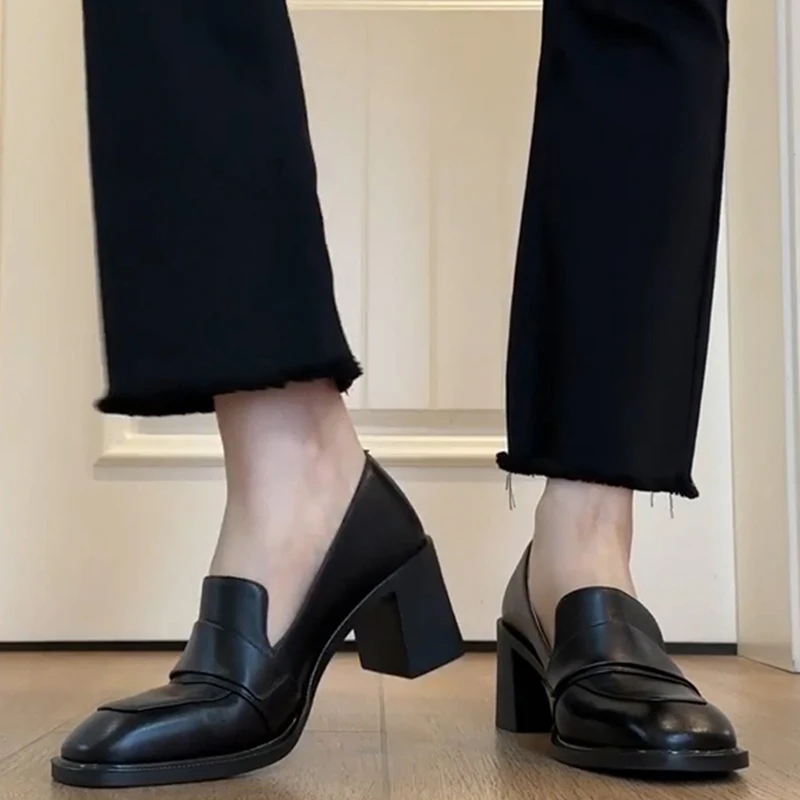
5.1 Heel Inspection and Maintenance
Heels require specific attention beyond standard leather care:
Regularly check for loose heel components by gently pressing the heel in different directions to detect wobbling.
Clean the heel material with appropriate products—leather heels need conditioning, while synthetic or stacked heels may require different care.
For wrapped leather heels, apply edge kote or color-matched polish to areas showing wear to prevent further deterioration.
5.2 Preventing and Addressing Heel Damage
Watch for these early warning signs of heel problems:
Uneven wear on the heel tip indicates walking imbalances that can accelerate damage.
Minor scuffs on leather-covered heels can be touched up with matching polish before they worsen.
When heel tips wear down to less than half their original thickness, replacement is necessary to prevent damage to the heel structure.
Consider heel guards or caps when wearing your loafers on rough surfaces like cobblestones or grates.
The construction quality found in our women’s high heel loafers collection benefits significantly from these targeted maintenance practices.
6. Solutions for Common Leather Loafer Problems
6.1 Water and Salt Stains
Quick action prevents lasting damage from moisture exposure:
For fresh water exposure, immediately blot (don’t rub) with an absorbent cloth, then stuff with paper to maintain shape during drying.
Address dried water spots by lightly dampening a cloth with distilled water, gently wiping the affected area, then conditioning once dry.
Remove salt lines using a solution of equal parts water and white vinegar applied sparingly with a cloth, followed by conditioning after drying.
Properly maintained loafers are essential for creating polished business casual loafer outfits that transition effortlessly from office to after-work events.
6.2 Scuffs and Minor Damage
Most minor damage can be addressed at home:
Assess the depth—surface scuffs can be treated with conditioner and polish, while deeper damage may need professional attention.
For smooth leather scuffs, use matching shoe cream to fill and blend the damaged area.
Suede requires a special eraser and brush to lift marks without damaging the nap.
6.3 Creasing and Shape Issues
Prevent and minimize unsightly creases:
Use shoe trees consistently to maintain shape and smooth out minor creases.
Apply leather conditioner to creased areas, which helps the leather remain supple and less prone to permanent creasing.
For significant shape distortion, stuff the toe box firmly with tissue while leather is slightly damp from conditioning to reshape gradually.
Women's Comfortable Flat Loafers, Women's Leopard Print Loafers, Women's Low Heel Loafers
$82.50 Select options This product has multiple variants. The options may be chosen on the product pageWomen's Block Heel Loafers, Women's Heeled Penny Loafers, Women's Monk Strap Loafers
$194.04 Select options This product has multiple variants. The options may be chosen on the product pageWomen's Block Heel Loafers, Women's Square Heel Loafers, Women's Square Toe Flat Loafers
Price range: $73.61 through $86.41 Select options This product has multiple variants. The options may be chosen on the product pageWomen's Black Platform Loafers, Women's High Heel Loafers, Women's High Platform Loafers, Women's White Platform Loafers
$106.67 Select options This product has multiple variants. The options may be chosen on the product pageWomen's Black Heeled Loafers, Women's Black Platform Loafers, Women's Block Heel Loafers, Women's Chunky Heel Loafers
$72.58 Select options This product has multiple variants. The options may be chosen on the product pageWomen's High Platform Loafers, Women's Wedge Heel Loafers
$171.07 Select options This product has multiple variants. The options may be chosen on the product page
6.4 Odor and Interior Care
Address interior freshness for extended wear comfort:
Neutralize odors by sprinkling baking soda inside overnight, then vacuuming it out in the morning.
Allow loafers to fully air out between wearings—ideally 24 hours with shoe trees inserted.
For stubborn odors, consider anti-microbial sprays designed specifically for leather footwear interiors.
Our women’s square heel loafers collection maintains its appeal much longer with these problem prevention techniques.
7. Proper Storage to Maintain Shape and Extend Lifespan
Proper storage is equally important as active cleaning:
Always insert wooden shoe trees between wears—cedar is ideal as it absorbs moisture while deterring insects and odor.
Store in a cool, dry place away from direct sunlight, which can fade and dry out leather.
Position heeled loafers upright, never stacked with weight pressing on the heels, which can cause warping.
Use breathable dust bags for protection while allowing air circulation—plastic bags trap moisture and promote mildew.
For seasonal storage, clean and condition thoroughly, insert shoe trees, and check occasionally for dust or pest issues.
These storage practices are particularly valuable for preserving the structured shape of best square block heel loafers between wearings.
8. When to Seek Professional Help
Some issues require expert intervention:
Deep cracks that penetrate through the leather surface require professional assessment.
Structural damage to the heel base or separation between components needs cobbler expertise.
Significant color loss or severe water damage often requires professional restoration techniques.
Heel replacement typically costs between $15-40 depending on material and design, which is far less than replacing quality loafers.
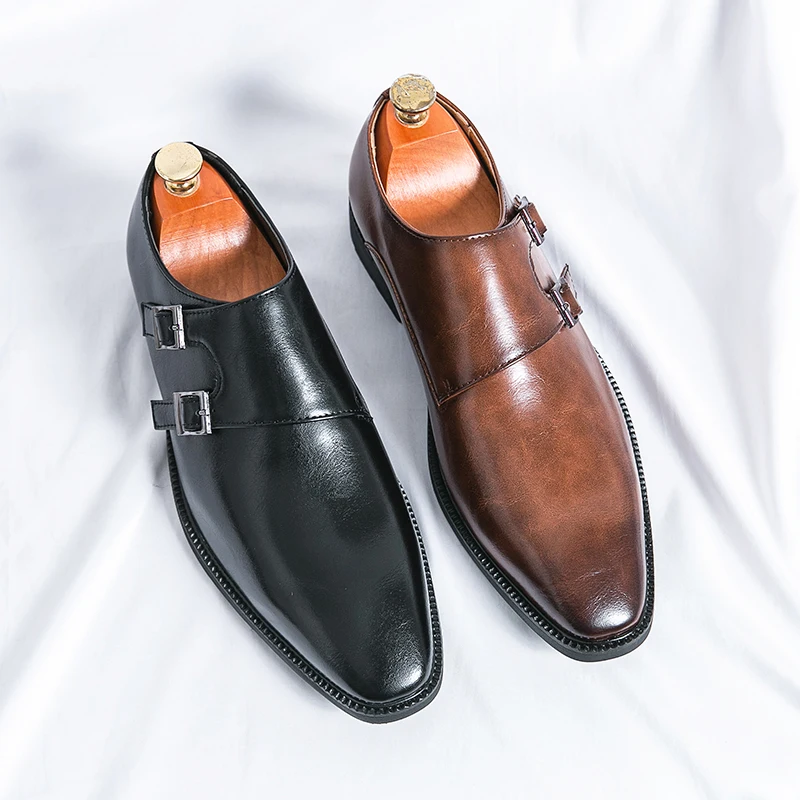
Professional care is an investment that extends the life of your quality footwear, making it economical in the long run compared to frequent replacements.
9. Adapting Care for Different Seasons and Weather Conditions
9.1 Rainy Season Protection
Moisture is leather’s enemy, requiring seasonal adaptations:
Apply water-repellent spray before the rainy season begins, reapplying monthly during wet periods.
After exposure to rain, blot gently with absorbent cloth and insert shoe trees immediately to maintain shape as they dry.
Never place wet leather near heaters or use hairdryers—this causes leather to dry too quickly, creating cracks and warping.
9.2 Winter Care Adjustments
Cold weather brings specific challenges:
Apply protective spray more frequently during winter to guard against salt damage.
Wipe down loafers immediately after exposure to snow or slush using a slightly damp cloth.
Increase conditioning frequency when exposed to indoor heating systems that draw moisture from leather.
9.3 Summer Maintenance
Heat brings different concerns for leather care:
Store leather loafers away from direct sunlight, which can fade colors and dry out the leather.
Clean more frequently during dusty summer conditions to prevent particles from embedding in leather pores.
Address perspiration effects by allowing full drying between wears and using cedar shoe trees to absorb moisture.
Our women’s leather penny loafers maintain their appeal through all seasons with these adaptive care approaches.
10. Frequently Asked Questions About Leather Loafer Care
How often should I polish my leather loafers with heels?
Most leather loafers benefit from polishing every 3-4 weeks with regular wear. Increase frequency if you wear them daily or in harsh conditions.
Can I wear my leather loafers in light rain?
With proper waterproofing treatment applied in advance, leather loafers can handle light rain. However, always dry them properly afterward and avoid wearing them in heavy downpours.
How can I tell when my heel tips need replacement?
Replace heel tips when they’ve worn down by about half their original thickness, or when you notice uneven wear. Waiting too long can damage the heel structure itself.
Is it normal for leather loafers to stretch with wear?
Quality leather loafers will slightly conform to your foot shape over time. This natural stretching improves comfort, but excessive loosening may indicate improper fit or low-quality materials.
How can I prevent squeaking in my leather loafers?
Squeaking often comes from internal friction. Try sprinkling a small amount of baby powder or cornstarch between the insole and footbed, or apply leather conditioner to areas where components rub together.
Can I use household products to clean my leather loafers in an emergency?
In emergencies, mild soap (like facial soap) and water can clean smooth leather, but always condition afterward. Avoid household cleaners containing harsh chemicals, alcohol, or vinegar on leather uppers.
How do I prevent color transfer from dark leather to clothing?
Allow polish and dyes to fully dry before wearing, and use a clean cloth to buff away any excess product. Quality leather properly finished should have minimal color transfer once fully dried.
At Artisan Haul, our women’s heeled loafers are designed with quality materials that respond beautifully to proper care, rewarding you with years of sophisticated style and comfort.

